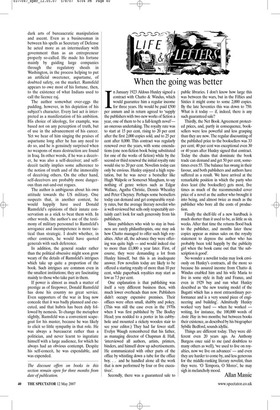When the going was better
In January 1923 Aldous Huxley signed a contract with Chatto & Windus, which would guarantee him a regular income for three years. He would be paid £500 per annum and in return agreed to ‘supply the publishers with two new works of fiction a year, one of them to be a full-length novel’— an onerous undertaking. The royalty rate was to start at 15 per cent, rising to 20 per cent after the first 2,000 copies sold, and to 25 per cent after 8,000. This contract was regularly renewed over the years, with some emendations (one non-fiction book being substituted for one of the works of fiction) while by the second or third renewal the initial royalty rate would rise to 20 per cent. Novelists today can only be envious. Huxley enjoyed a high reputation, but he was never a bestseller like Hugh Walpole or Somerset Maugham, to say nothing of genre writers such as Edgar Wallace, Agatha Christie, Dennis Wheatley and Peter Cheyney. Perhaps some bestsellers today can demand and get comparable royalty rates, but the average literary novelist who is well-reviewed but sells only respectably certainly can’t look for such generosity from his publishers.
Since publishers who wish to stay in business are rarely philanthropists, one may ask how Chatto managed to offer such high royalties. After all, the advance they were offering was quite high — and would indeed rise to more than £1,000 a year later. First, of course, they were demanding a lot from Huxley himself, but this is an inadequate answer. Few novelists today are likely to be offered a starting royalty of more than 10 per cent, while paperback royalties may start as low as 7.5 per cent.
One explanation is that publishing was itself a very different business then, with much lower overheads than now. Publishers didn’t occupy expensive premises. Their offices were often small, shabby and pokey. (This was still the case even in the 1970s when I was first published by The Bodley Head; you nodded to a porter in his cubbyhole and mounted a rickety wooden stair to see your editor.) They had far fewer staff. Evelyn Waugh remembered that his father, as managing director of Chapman & Hall, ‘interviewed all authors, artists, printers, binders, and himself drew up advertisements. He communicated with other parts of the office by whistling down a tube for the office boy. . . and he handled alone all the work that is now performed by four or five executives’.
Secondly, there was a guaranteed sale to public libraries. I don’t know how large this was between the wars, but in the Fifties and Sixties it might come to some 2,000 copies. By the late Seventies this was down to 750. What is it today — if, indeed, there is any such guaranteed sale?
Thirdly, the Net Book Agreement protected prices, and, partly in consequence, booksellers were less powerful and less grasping than they are now. The regular discounting of the published price to the booksellers was 33 per cent; 40 per cent was exceptional even 30 or 40 years after Huxley signed that contract. Today the chains that dominate the book trade can demand and get 50 per cent, sometimes even 55. The balance has swung in their favour, and both publishers and authors have suffered as a result. We have arrived at the remarkable position in which the party who does least (the bookseller) gets most, five times as much of the recommended cover price of a novel as the author who brought it into being, and almost twice as much as the publisher who bore all the costs of production.
Finally the shelf-life of a new hardback is much shorter than it used to be, as little as six weeks. After that time the returns flood back to the publisher, and months later these copies appear as minus sales on the royalty statement to depress the author who has probably been told happily by the publicity girl when the book came out that ‘the subscription is good’.
No wonder a novelist today may look enviously on Huxley’s contracts, all the more so because his assured income from Chatto & Windus enabled him and his wife Maria to live in some style in Italy and France, and even in 1929 buy and run what Huxley described as ‘the new touring model of the Bugatti which has a most extraordinary performance and is a very sound piece of engineering and building’. Admittedly Huxley worked very hard — when he worked writing, for instance, the 100,000 words of Antic Hay in two months; but between books their existence, as described by his biographer Sybille Bedford, sounds idyllic.
Things are different today. They were different even 20 years ago. As Anthony Burgess once said to me (and doubtless to many others as well), ‘we used to live on royalties, now we live on advances’ — and even they are harder to come by, and less generous for the middle-ranking literary novelist, than they were. ‘O Tempora, O Mores’, he may sigh in melancholy mood.
Allan Massie










































































 Previous page
Previous page